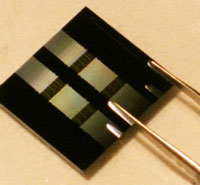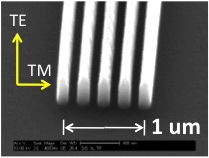Silicon photonics and hybrid photonics
- [2023] 100 GHz Bandwidth, 1 Volt Near-infrared Electro-optic Mach-Zehnder Modulator.
[Optica]
- [2023] Fabrication of Hybrid TLFN Electro-optc modulators using silicon or silicon nitride waveguides.
[J Phys Photonics]
[JOSA B]
- [2023] Buried-electrode Hybrid TFLN modulators.
[IEEE PTL]
- [2022] High OMA electro-optic modulation using silicon micro-resonators: 10 mW optical power handling.
[Optics Express]
- [2019] A perspective on future 3D Integrated Photonics using
lithium niobate thin films. [IEEE Nanotechnology Magazine]
- [2018] Hybrid lithium niobate Mach-Zehnder electro-optic modulator on a silicon photonics platform, exceeding 100 GHz 3-dB electrical bandwidth, co-authored with reseachers from Sandia. [Optics Express]
- [2016] Hybrid Lithium Niobate - Silicon photonic passive devices and circuits. Back-and-forth mode transitions, bends, inter-layer coupling, interferometric circuits.
[Scientific Reports]
- [2014] Silicon photonic tunable add/drop/power control (variable optical attenuator, VOA) for
four C-band WDM channels. First generation device: thermo-optic tuners on microrings, electro-optic carrier injection VOA,
single polarization. [IEEE Conf. PDP]
- [2014] Thermo-optic MZI switch with five cascaded
thermo-topic phase-shifters show low power, microsecond-scale
cross-bar switching of twenty wavelength channels in UCSD-MORDIA,
each carrying 10 Gbit/second data concurrently.
[CLEO 2014]
- [2014] Method to extract the electronic
carrier-induced loss and coupling coefficients of modern
thermo-optic and electro-optic silicon MZI based 2x2 switches
(Sandia, IBM and Kotura-Oracle) from the transmission spectra.
[CLEO 2014]
-
[2013]
Demonstrated 100 dB contrast filters (cascade of 2 chips) with 2.8
dB insertion loss, and group delay ripple < 5 ps; built using
two > 50 dB extinction filters with 1.4 dB loss, and with
thermally-tunable center wavelength and bandwidth (on-chip
heaters)
[IEEE PTL].
Nonlinear and quantum optics on a chip
QUANTUM
- [2023] Electro-optic control of biphoton generation using hybrid photonics, using a TFLN modulator integrated with a Si photonic photon-pair source.
[Optica Quantum] [CLEO 2022] post-deadline paper
- [2021] Voltage-Controlled Fast and Low-loss Single-Photon Cross-Bar Switch Using Integrated Photonics.
[Journal of Lightwave Technology] [OFC2021] post-deadline paper
- [2019] Oscilloscopic capture of 100 GHz modulated optical waveforms using a superconducting nanowire single photon detector. [OFC 2019]
post-deadline paper
- [2019] Thin-film lithium niobate waveguide entangled photon-pair and heralded single photon generation with CAR > 67,000 and g(2)(0) < 0.025. [FIO 2019] post-deadline paper
- [2018] Photon-pair generation using spontaneous four-wave mixing in silicon microrings, pumped using a silicon hybrid laser, co-authored with researchers from Intel. [APL Photonics]
[CLEO 2017] post-deadline paper
- [2017] Silicon photonic entangled photon-pair and heralded single photon generation with CAR > 12,000 and g(2)(0) < 0.006.
[URL]
- [2016] Pair generation at 1550 nm using only a few microwatts of optical pump power
using a Si microring resonator.
[Opt Express].
- [2015] We achieve stable pair generation over 30°C temperature variation
by monitoring the microring resonance using a (Ge-free) Si p-i-n photodiode as part of the ring.
[Appl. Phys. Lett.].
- [2015] Using two-photon (Franson) interferometry, we measure the entanglement of
photon pairs generated from an optically-pumped silicon photonic device operated at room temperature.
[Opt. Express].
-
[2014] Controlling the joint spectral intensity (2-dimensional photon spectrum)
of photon pairs using a silicon chip, and varying the Schmidt degree of entanglement discretely over a
wide range without beam-shaping.
[Nat Commun]
- [2013] Spectrally-multiplexed ("comb")
generated by a coupled-microring silicon pair source, and temperature tuning
of the wavelength
[Opt
Lett] [CLEO 2013 CF2M.4].
- [2012] Heralded single photon generation from
a CMOS-compatible silicon nanophotonic chip at room temperature,
based on optically-pumped spontaneous four-wave mixing.
[Appl
Phys Lett].
Press coverage:
[NIST
Tech Beat], [Photonics.com]
[Optics and Photonics News]
"Quantum Light from CMOS-compatible Silicon
Microresonators" IEEE Photonics Conference paper TuW2 (2012)
[invited].
"Generating photon pairs using silicon photonics" IEEE Group IV Photonics,
paper ThC.1, Paris, 27-29 August (2014) [invited].
NONLINEAR
- [2020] Shallow-etched thin-film lithium niobate waveguides for highly-efficient second harmonic generation. [Opt. Express]
- [2019] Periodic poling and non-destructive diagnostic techniques of x-cut thin-film lithium niobate on insulator (LNOI) for second-harmonic generation.
[Opt. Express]
[J. Applied Phys.]
- [2014] Tunable higher-order microring filters were integrated on the same chip as a carrier-swept ring mixer, to separate the generated idler wavelength from the residual pump and unconverted signal
[Opt Lett 2014].
- [2013] Using reverse-biased silicon microrings, CW four-wave mixing conversion efficiency of -13.4 dB is achieved using 20 um radius micro-ring resonators with only 2.5 mW pump power
[IEEE PTL 2013]. Silicon rib waveguides (passive loss of 0.74 dB/cm) with free-carrier lifetime reduction via reverse
biased PIN diodes show CW four-wave mixing efficiency of -8.2 dB (-4.4 dB if both signal and idler are measured at the output) with 160 mW pump power (about 2X reduction
compared to other reports in literature) [CLEO 2013].
- [2014] Triply-resonant four-wave mixing using coupled silicon microresonators. Wavelength conversion efficiency was improved by 20 dB, enough to demonstrate open eyes at 10 Gbps for converted wavelengths using a CW pump
[Opt Lett 2014]
- [2011] Low-power CW four-wave mixing in silicon CROWs, demonstrating +16 dB conversion enhancement relative to a conventional silicon waveguide of
equivalent length, a nonlinear coefficient geff=3720 /(W.m) and flat conversion in channels spanning more than 10 THz
bandwidth (signal to idler)
[Opt Lett 2011].
Intra-band and inter-band four-wave mixing using a continuous-wave (CW) pump in silicon CROWs
[CLEO].
-
[2010] Four-wave mixing in silicon waveguides at wavelengths above 2 um, demonstrating a nonlinear coefficient g=103 /(W.m) and flat conversion over more than 220 nm bandwidth (signal to idler)
[Nat Photon]
[Frontiers in Optics, 2009]
- [2010] Two pump four-wave mixing in silicon waveguides, showing multicasting of a pulsed signal into several idler wavelengths
[Fronters in Optics, 2010].
Coupled micro-resonators: science and applications
- [2014] Electronic on-off switching control over optical
Anderson localized modes using a
lithographically-fabricated silicon photonic
waveguide infiltrated by about 100 sub-micron-scale p-n junction
diodes. [Nat Nano]
-
[2010] Silicon microring coupled-resonator
optical waveguides (CROWs) consisting of upto 235 coupled
microring resonators [Opt
Lett].
- [2010] Statistical measurements of intensity
and group delay, showing scaling behavior with length, and
evidence of non-localized propagation through 235-ring silicon
CROWs [OpEx].
- [2007] Effect of disorder on slow-wave
waveguides, deriving a simple expression for the maximum
achievable slowing factor (S=c/vg) [Opt
Lett].
- [2011] How many rings can be coupled in a CROW
before disorder-induced bandwidth collapse occurs? Theoretical and
experimental studies in silicon microring CROWs [Opt
Lett].
- [2008] Light localization in SOI coupled
resonator optical waveguides, demonstrating strong localization of
Bloch excitations in a disordered 1D chain of 100 resonators [Nat
Photon].
-
[2011] Accurate transfer matrix modeling of long
CROWs, including silicon waveguide dispersion and disorder effects
[PTL].
- [2014] 20 dB improvement in CW four-wave
mixing in silicon CROWs with electronic free-carrier removal [Opt Lett]
- [2001-2004) Earlier tight-binding [OpEx,
2001] and transfer-matrix analysis [OpEx,
2004] of CROWs. Tight-binding analysis of holographic pulse
storage in CROWs [PRE,
2001]. Nonlinear interactions in CROWs [PRE,
2002]. "Frozen" light CROW soliton theory [PRE,
2002].
Experimental and theoretical methods
- [2020] Full-Speed Testing of Silicon Photonic Electro-Optic Modulators from Picowatt-level Scattered Light.
[OFC 2020]
post-deadline paper
- [2019] Oscilloscopic capture of 100 GHz modulated optical waveforms at femtowatt power levels.
[OFC 2019]
post-deadline paper
- [2012] Static rerouting of the optical light
path on a silicon chip, using tip-induced nano-oxidation of 2x2
components: microring add/drop filter and Mach-Zehnder
interferometer [CLEO/QELS
2012].
- [2011] 0.002 nm precision set-and-forget
alignment of silicon photonic microring resonators and Mach
Zehnder interferometers using nano-oxidation [OFC
PDP, 2011] and [Opt
Lett]
- [2011] Measuring statistical distributions of
group delay in silicon nanophotonic waveguides rapidly and
accurately using the Luna OVA5000 and unfiltered optical
amplification [IEEE PTL].
- [2010] Infrared imaging
and diagnostics of multi-resonator optical circuits, extracting
individual resonator eigen-frequencies and coupling coefficients
in a rapid and non-invasive way [Opt
Lett].
Spotlight
on Optics, commentary by Dr. J. E. Heebner.
- [2012] High dynamic range infrared microscope
imaging of silicon nanophotonic devices, overcoming conventional
signal-to-noise ratio limitations in dB-scale imaging, by
stitching together several images taken at different integration
time, using a commercial 12-bit InGaAs infrared (1550 nm
wavelength) camera [Opt
Lett].
-
[2009] Numerically-assisted coupled mode theory
for more accurate design of strongly-coupled and compact
silicon-on-insulator waveguide couplers and waveguide arrays [OpEx].
Other work in chip-scale photonics
- [2008] Giant birefringence in multi-slot SOI
waveguides. We demonstrate record giant birefringence, nearly
twice as large as has previously been achieved (Dngroup
= 1.5 over more than 60 nm of bandwidth near 1550 nm) using a
multi-slotted silicon nanophotonic waveguide [OpEx].
- [2006] Microfluidically-tuned polymeric
microring resonator with microfluidic chip for sensing small
changes in fluidic composition by refractive index monitoring of a
flow [Appl Phys Lett].
This work was one of the earliest "opto-fluidic" micro-resonator
demonstrations.

